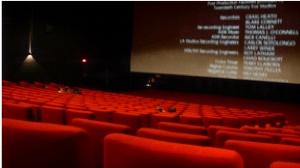Product Features are Like Film Credits
If the product is no good, no one cares

Have you ever sat in the cinema at the end of the film and watched everyone get up and leave once the credits start rolling? At best you may see a few that have been guessing [since the start of the film] who the actor is that played a certain role, and then you find out that it wasn’t the person you originally thought they were. But what about the mass of other industry specialists that have spent the past couple of years working on the numerous specialities that are needed to complete the film.
Even once you have listed the actors, credits can run for over 5 minutes, listing all those different non-acting contributors, such as: stunt actors, visual effects, costume designers, 2nd unit directors, lighting, sound & music, and many more. So, if cinema goer’s don’t see the value in appreciating who put the film together, are they really important?
Think about what the film would have been like if it had no:
- Lighting - then you wouldn’t see the movie stars
- Music - with only captions in ‘Bohemian Rhapsody’
- Costume - dressing in jeans and t-shirts wouldn’t look so good in ‘The Favourite’
- Visual Effects - seeing the wires holding up props and people in the backdrops for “First Man’
- Animators - Jungle book would be more like Etch-a-sketch
- Extras - A crowd scene would look more like a dentist waiting room
- Script Prompters - fancy all your films flowing like “The Kings Speech’
Taking away the actors, there are hundreds of individuals or backroom staff that all add a valuable contribution to the finished product. A film director acknowledges that they need all of these disciplines and not just a cameraman to produce the final product. Do it right and you may get onto the red carpet at the Kodak Theatre, if not then you will end up being covered by ‘rotten tomatoes’
This is no different in the tech industry, every business needs to recognise that product features, once agreed of their value (to the customer), contribute to the success you are striving for. Features add to the product realisation or enhance an existing product, bit like lighting and sound enhancements add the the mood of a film.
Think about what happened with these:
- Why produce a phone solely for twitter (Twitter Peek) and Facebook Phone
- Who forgot about privacy and the cultural backlash (Google Glass)
- Damaging a good pair of sunglasses with MP3 additions (Oakley Thump)
How about the Tech Market:
- COPAN - $110 million invested. Copan was well differentiated. The weakness was their not understanding, focusing and exploiting its sweet spot. A consequence of an incomplete or erroneous market understanding and a sole reliance on the internal body of experience and knowledge.
- NAVDY - $42 million invested. Navdy, which made an in-car heads-up display that projected info like navigation on to your windscreen, …the heads-up display market is very crowded and the jury was still out if it would be a distraction to the driver Together, all this makes for a tricky product/market fit.
- Jawbone - $929 million!!. Jawbone became one of the most spectacular failures in the history of startups. Even after 17 years of business, not respecting how your market and customer needs are, resulted in Jawbone failing to hold on to significant market share for its line of headsets, fitness trackers, and wireless speakers.
Even the big boys get it wrong:
- SKYPE - trying to find a home because of fit. eBay bought the Internet telephony upstart called Skype in 2005 for $2.6 billion hoping online buyers would prefer VoIP and video calls over e-mail. Wrong! E-mail is good enough for online buyers and sellers. eBay didn't asked their clients what they wanted, so this was a tough and expensive lesson for eBay. After four unfulfilling years eBay sold Skype at a loss to private investors for $1.9 billion. Skype was picked up by Microsoft (MSFT) in May 2011 for a cool $8.5 billion.
- NOKIA - Consumers and Carriers were not wowed. In 2013, Microsoft CEO Steve Ballmer saw an opportunity in Nokia. Ballmer led Microsoft’s purchase of Nokia for over $7B in a deal finalised in 2014. But the Lumia phone line, didn’t garner the developer and carrier partnerships needed for the phone to catch on. Ballmer left that same year and new CEO Satya Nadella had to do significant restructuring and layoffs to streamline the company, including cutting 15,000 Nokia employees. In 2015, the acquisition was written down for $7.6B.
Its clear that your business strategy needs to include everyone in the company that can add value to the program. Size of company is immaterial as this effects everything from start-up to corporates.
See how SynergySix helps to create a collaborative approach to your product, features, markets and consumers with our SynergySix Flow Chains






